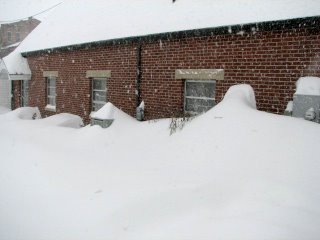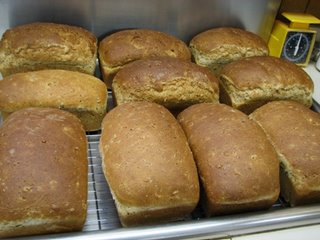
It started snowing early this morning and by 7 AM we had a blizzard warning. This photo was taken at 3:30 PM and by 5 PM 13 inches of snow had fallen. We expect it to keep snowing until way past midnight and the prediction is that tomorrow will be worse with blowing snow. What a day! I’ve had time to clean the fridge and pantry, do some website stuff, and get these two recipes typed (see previous post). I thank God for the day at home, but mostly for the day at home with the luxury of electricity, food, and heat. I am humbled by these gifts when many are without.
A SALAD TO END ALL SALADSThis salad was introduced to me by our friend, Stan, this past month when we were visiting in the Northwest. Stan and his wife have been one of my greatest inspirations for cooking for almost 30 years. They taught us how to make bread, to garden, to make salads, and most of all, to offer hospitality with flair. I admire them greatly and am thankful for their mentorship in all things, especially service and ministry.
I like this salad for several reasons. It is low fat with no dressing, it keeps well for several days in the fridge, and most of all, it reminds me of a fresh chutney I made for grilled tilapia in Uganda. You are free to use whatever amounts of veggies you have on hand, if you like something particularly well, add more, but please include the jicima, pineapple, peppers, cilantro and ginger…..they are the flavor and texture base for this large, wonderful salad. Try it, you’ll love it. To date, I’ve not indulged in the grape tomatoes in the salad…..I just can’t imagine tomatoes and pineapple together, but Stan insists the tomatoes are perfect. I’ll give in soon.
1 or 2 Jicimas (Mexican potato) peeled, and sliced into matchsticks
A yellow, red and green pepper, diced or cut into matchsticks
sugar peapods
carrots, diced, matchsticks, or I use a peeler to make thin slices
fresh cilantro leaves
1 fresh pineapple, peeled and diced
1 bag of Spring Mix lettuce
1 cup craisins
2 inches of fresh gingerroot, finely diced
celery, diced
grape tomatoesThis salad made two very large bowls. As I wrote, it keeps well in the fridge for several days and actually the flavors intensify as it sits.
I divided the ingredients into two batches: 1 batch with jicima, peppers, pineapple, craisins, and gingerroot, and another batch with the spring mix, carrots, pea pods, celery, and cilantro leaves. I stored the two batches separtely. I wanted to use the salad for 2 different meals and mixed the salad together ½ at a time before each meal. Mix batches together several hours before the meal. Other ingredients that have been added: avocados and apples.
Salt-rising breadSalt-rising bread is one of the oldest breads in this country. It has an unusual flavor and a very smooth texture. It is a remarkable bread that many people love and many buy on a regular basis. A bakery in Muncie makes salt-rising bread every week on Wednesday and Friday.
It is an unpredictable bread. But it is a worthy recipe,so give it a try.
To keep the starter at a steady temperature, which the recipe requires, leave it in an electric oven with the light on--this will provide just enough warmth--or in a gas oven with the pilot light on.
The foam that forms may not be one, two, or three inches in thickness, but if it FOAMS at all make the loaf and see what happens. Good luck!
For the salt-rising starter: 1 1/2 cups hot water
1 medium potato, peeled and sliced thin
2 tablespoons white or yellow cornmeal
1 teaspoon granulated sugar
1/2 teaspoon salt
Mix the starter ingredients and pour into a 2-quart jar or a deep bowl that has been rinsed well with hot water. Cover with a lid or plate. Put the jar into a larger bowl or pan and surround with boiling water. Cover the large bowl with plastic or a towel, and cover this with three or four towels or a blanket. It should stand at a temperature of 100 degrees when the mixture is finally foaming. The electric oven turned to warm will provide the right temperature, and so will a gas range with a pilot light on. In either case, let the starter stand about 12 hours, or until the top is covered with 1/2 to 1 inch of foam. Sometimes it will take longer to foam, even 24 hours, but continue to keep it warm.
FOR THE BREAD Liquid from starter (above)
1/2 cup warm water (100 to 115 degrees, approximately)
1/4 teaspoon baking soda
1/2 cup undiluted evaporated milk or 1/2 cup lukewarm whole milk
1 tablespoon melted butter
1 teaspoon salt
4 1/2 to 5 1/2 cups all-purpose or hard-wheat flour
Let the liquid from the potato starter drip through a strainer into a mixing bowl, and then pour the warm water through the potatoes, pressing out as much liquid as possible. Discard the potatoes.
Add to the drained liquid the soda, milk, melted butter, and salt, mixing well.
Stir in 2 cups of the flour and beat until very smooth. Stir in the remaining flour, a cup at a time, until a soft dough is formed, using up to 4 1/2 cups.
Put a cup of flour on the bread board and turn the dough onto it. Sprinkle a little of the flour on top of the dough and knead lightly for 10 to 12 minutes, or until the dough is smooth but still soft.
Divide the dough and shape into two loaves (this bread does not have a rising between the kneading and the shaping).
Place in well-buttered bread pans, brush the top of each loaf with melted butter, cover, and place in a warm, draft-free place to rise until doubled in bulk. (This will take longer than regular bread--as long as 4 to 5 hours, maybe more.)
Bake in a preheated oven at 375 degrees for 35 to 45 minutes, or until the loaves shrink from the sides of the pans. Remove from pans to cool.





